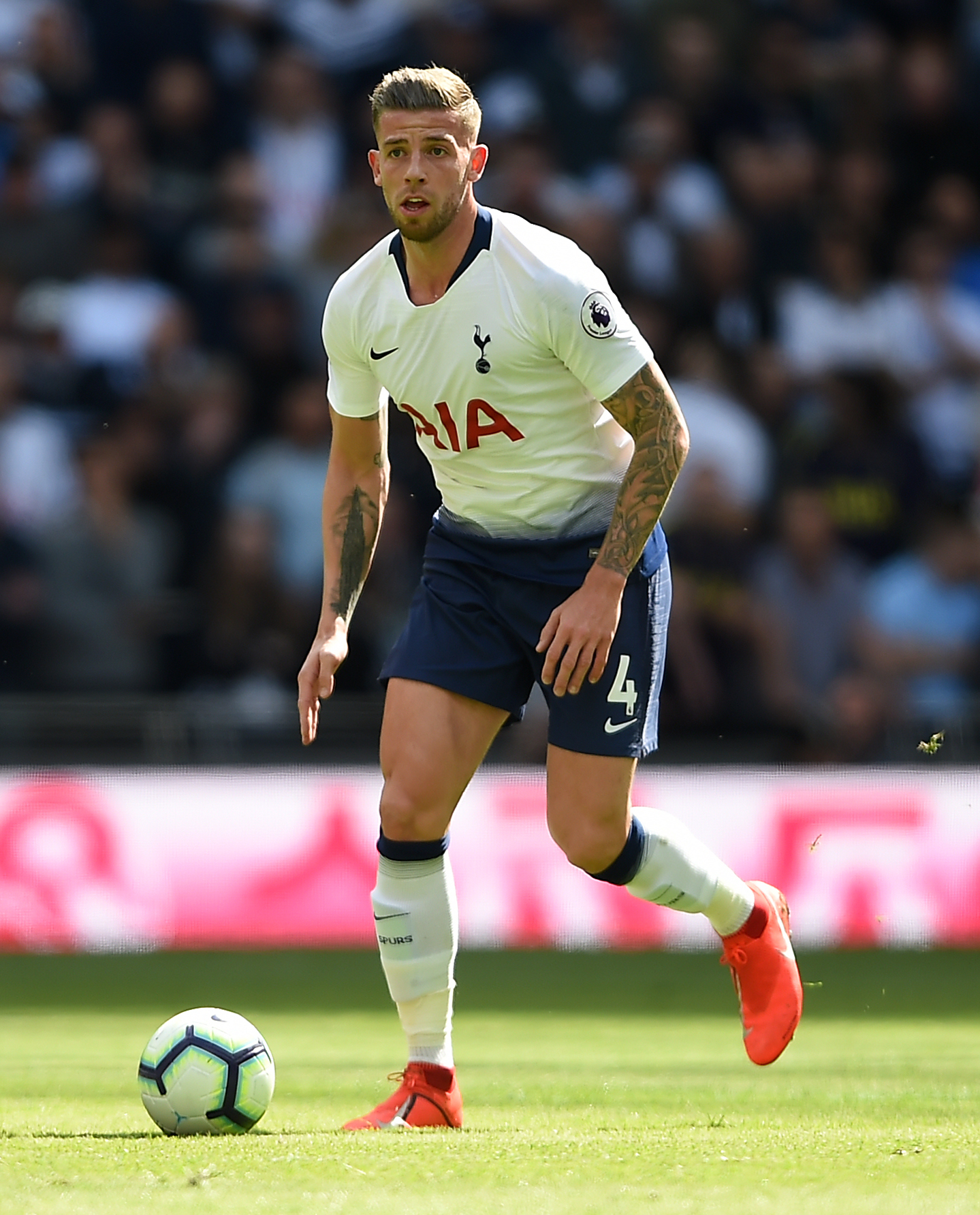Tottenham Hotspur have a weird, broken, magical squad. Because the club didn’t sign any players either over the summer or in January, this special group was too thin to put together that unique alchemy week in and week out. But, the team’s peak, which has only existed for a stretch of perhaps five matches this season, demonstrated a high flying act constructed by Mauricio Pochettino that I’ve dubbed the Air Raid Offense. It’s that tactical system that has been the framework for Spurs’ success this season.
Air Raid is an American football tactical system. What undergirds the Air Raid is a belief in stretching the field vertically, sending receivers down the field, spread out horizontally, with staggered depths, each reading the defense. I quoted Roger Sherman in my original piece breaking down the Air Raid’s basics, explaining the system’s classic play, called Four Verts:
Take the Air Raid’s signature play, Four Verticals. It sounds like an 8-year-old’s preferred play call, the real-life version of Da Bomb from NFL Blitz, but it does more than just stretch defenses deep. Four Verts also exploits the field horizontally, by having four receivers run evenly spaced routes across the gridiron. Not every pass is a deep shot; in fact, many Four Verts plays end with midrange attempts to receivers whose defender is trying to prevent a deep heave. As Smart Football’s Chris B. Brown explains, the idea isn’t “just run into the end zone.” It’s “stay in your vertical lane, but get open.”
While traditionally in American football, coaches sought to move the chains (keep the ball) through short throws and runs and occasionally throw the ball deep, the Air Raid offense threw the old playbook out to ask, why? What if we took more risks, tried to gain more yardage quickly, and played a higher risk, higher reward strategy? What if we stretched defenses and just didn’t bother with offensive plays near the line of scrimmage? Let’s make opposing defenses cover more square yardage and make tougher decisions. The Air Raid prioritizes speed, quick decisions, and relatively accurate passing from quarterbacks that can sling the ball around the field. It deprioritizes size, strength, breaking tackles, and short gains.
In December of 2018, Mauricio Pochettino lost every semblance of the midfield he used to have. Mousa Dembele, once one of the strongest defenders and most technically gifted press resisters in soccer, was a shell of himself and was shipped off to China where he was able to dominate once again despite being 1.5 shells of himself. Eric Dier had appendicitis and a case of the being awfuls. Victor Wanyama was yet to play. Tottenham’s two true midfielders were a recently recovered and improving defensively Harry Winks and a no-longer awful Moussa Sissoko. Gone was Pochettino’s ability to play the 4-2-3-1 or 3-5-2 systems that had allowed him to press, control, and bruise results in 2016-2017 and 2017-2018. Tottenham’s shot differential plummeted.
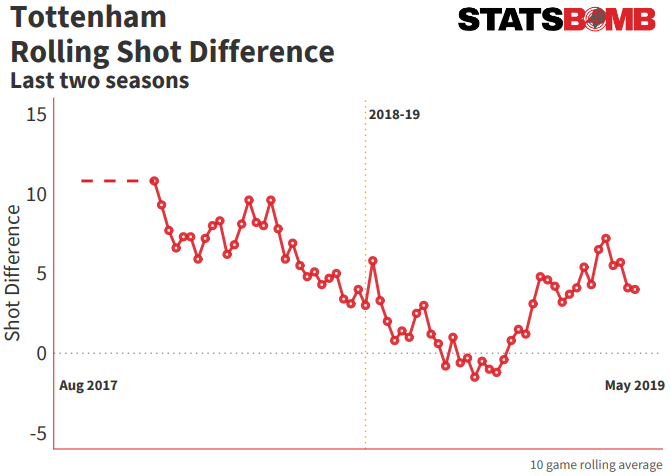
What remained of Tottenham’s squad in December was seven foundationally great players and four players that Pochettino had to manage around. Harry Kane and Son Heung-min are two elite strikers with immensely complementary skills. Kane and Son are two of the best finishers in the world. Son is incredibly fast and has the ability to crush the ball with both feet, from anywhere on the pitch. Kane is not only one of the great shot getters in the world – especially after mostly recovering his proprioception from his March 2018 ankle injury (we’ll get to this more) – but also incredibly adept at receiving the ball in the middle of the park and picking out a pass to continue the attack going forward.
Dele and Eriksen are very different players who share some important similarities. Both have incessant motors, receiving passes constantly when Spurs have the ball and pressuring constantly constantly when they don’t.
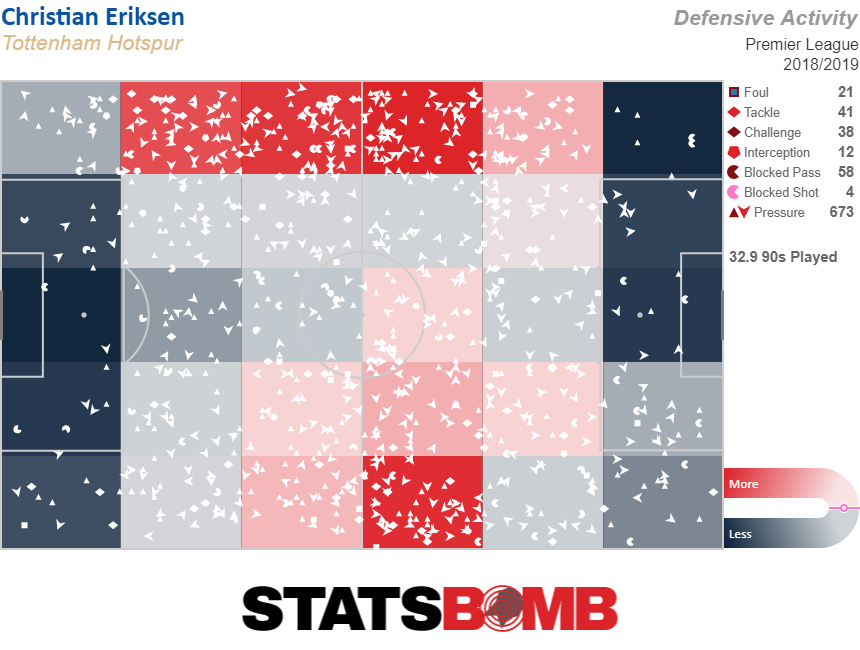
Dele runs with long strides that allow him to be everywhere on the pitch, all of the time, pressuring the ball and finding space in the box to get a shot or find a pass. He leads Spurs in, and was 13th in the Premier League with 6.32 pressure regains per 90 minutes but still manages to find himself on the end of chances constantly.
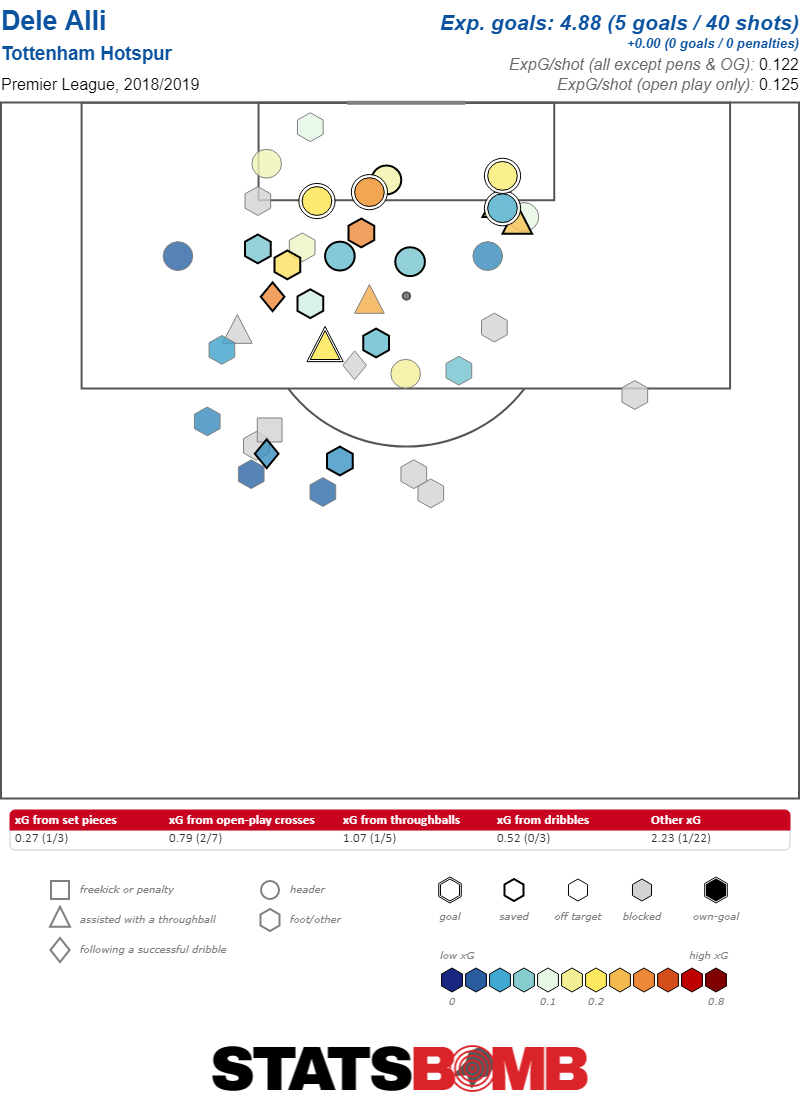
Eriksen roams the pitch, harrying opposing players, recovering the ball, and using his passing ability to create plays from all over the pitch. He led Spurs in both overall key passes with 2.31 per 90 and open play key passes with 1.70, figured that placed him eighth and tenth in the Premier League respectively. Together, they allowed Tottenham to seemingly have extra attackers and midfielders, while lacking both.
Then there are Toby Alderweireld and Jan Vertonghen. The longtime, multiclub and national teammates are two of the most skilled defenders in the world, both in defense and going forward. Alderweireld in particular can hit diagonals for sixty yards like almost no defender alive. It can often be hard to quantify passing in numbers, but Spurs clearly relied on Alderweireld as an engine to move the ball into the final third. No outfield player in the Premier League played more successful long balls than Alderweireld's 9.17 per 90 minutes and no center back attempted more unpressured long balls than his 11.48. Despite that he maintained an overall passing completion percentage of 89%. His combination of assurance on the ball and accurate long distribution paint a picture of a player who looks more like a midfield quarterback in possession than one of the league's most assured defenders.
Those six players and the best shot stopper in the season’s Premier League campaign in Hugo Lloris are the sorts of players you can win a Premier League title with. With no solidity in midfield and this collection of talents in the squad, Pochettino improvised the Air Raid by asking the following: if we cannot win or control the ball in midfield, why grant that a midfield should exist?
With Kane and Son up top, Alli and Eriksen able to play two positions at once, and Vertonghen and Alderweireld able to function like quarterbacks, Spurs were able to do soccer’s version of “four verticals.” This is not the stuff of Big Sam’s POMOs, Tony Pullis, or Cardiff. What the Air Raid unleashed was the ability to play short, intermediate, and long passes to create an attack from a turnover, as long as it was vertical. “Stay in your lane, but get open.” What it also meant, was trailing runners coming at all angles into the box when the ball had been advanced.
Statistically, Tottenham’s Air Raid showed in the numbers in a variety of ways this season. Spurs are fifth in the Premier League in non-penalty expected goals per 90 with 1.30 per match, but just tenth in passes completed in the penalty area with only 2.37 per match. They have the most direct attack in the league measured by looking at a ratio of the distance towards goal from the start of a possession that ended in a shot, divided by the total distance traveled in buildup to the shot.
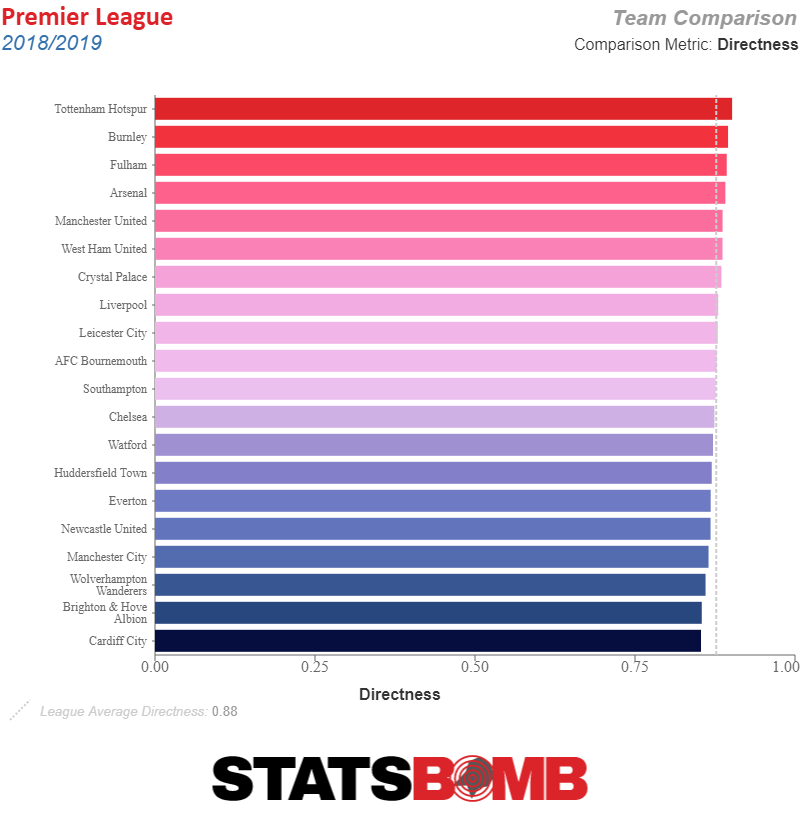
The blazing attack allowed Spurs to get their great finishers in space, without many defenders between them and the goal. They had by far the most counter attacking shots per match in the Premier League (defined as shots generated within 15 seconds of a possession that originates from their own half).
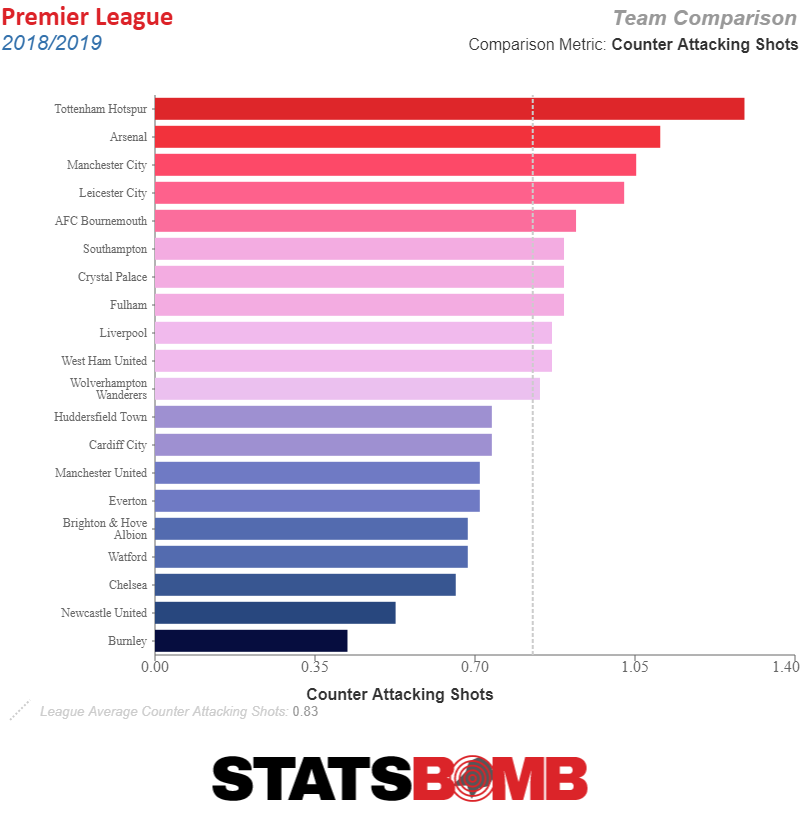
The tactical recognition of Moussa Sissoko’s deficiencies as a midfielder was also the move that finally unleashed the best of him, forcing Pochettino to think about what he does bring to the table rather than what he takes away. Sissoko has been a paradoxical player for most of his time at Spurs and mostly a bad one. He’s not good enough to play against the best teams and not technical enough to play against the bottom half of the Premier League where teams force Spurs to break them down in the final third. But his physical talents have always been there, it was just a matter of figuring out what to do with them. He has no ability to be a press-resistant midfielder because his ability to hold the ball is relatively mediocre. He’s not a particularly great passer. What he does have is incredible top flight speed, an indefatigable motor, and good open field dribbling.
By playing in transition constantly, Sissoko was unleashed to get up and down the pitch, carrying the ball forward with driving runs and making runs in behind to stretch the defense, while also slowing attacks by getting into good spaces and protecting Kieran Trippier on Tottenham’s right. With Tottenham moving from the grinding order of the Mousa Dembele era Spurs to the helter skelter Air Raid, Sissoko climbed chaos’s ladder and earning earnest chants of his name from Tottenham fans during Spurs remarkable semifinal comeback at the Cruyff.
The Air Raid in its purest form was mostly short lived this season, when the DESK quartet of Dele, Eriksen, Son and Kane was healthy with Harry Winks at the midfield base. In a three match mid-December stretch Spurs ripped off high flying wins against Bournemouth (5-0), Everton (6-2), and Arsenal (2-0 in the League Cup). While the gaudy goal totals rightly suggest that they ran hot during those matches, the hot finishing complemented Air Raid fully taking flight.
In the following clips from that time period you can see Kane coming deep to receive long, direct passes, and making snap decisions to find teammates in space. In others the ball moves quickly to Kieran Trippier, Dele, and Eriksen who find Son getting in behind. The ball frequently moves from the back directly to Kane, Dele, or a full back, but rarely directly to the box as it did when Tottenham were forced to play Llorente in the Champions League. Sissoko is often running vertically, and players come trailing frequently. Indeed on two of the goals and one of the chances, it’s a late arriving player who scores off a rebound. The verticality and chaos gave Tottenham a chance to play to its strength, directly linking its great passers in the back to its talented, well-rounded attacking players, without worrying about their lack of midfield control.
The Air Raid Against Liverpool
Early in the season, Nathan Clark [link] put together a smart video taking Pochettino’s words after losses to Inter and Liverpool discussing how Spurs’ dealt with the two teams’ respective presses. With Liverpool’s slightly lower press this season, Spurs passed around the back, and were unable to play through the middle of the pitch, frequently sending the ball long and recycling possession to Liverpool. Against Inter, Pochettino’s complaint was that Spurs passed out of the back against the press well, but were languid in possession having broken the press.
In both instances, Pochettino wanted Spurs to play faster and more vertically. Pochettino’s Spurs had tried to go play Liverpool like for like in that match and in the prior two years, to little success. Coincidentally, one of the first times Pochettino ever went away from his battering ram, pressing approach and towards what would presage this season’s Air Raid was in October of 2017 against Liverpool. Mousa Dembele and Eric Dier, his usual midfield two were both out. Spurs were forced to play a 3-5-2 with Harry Winks, Dele and Eriksen in midfield. The attack in that match focused on vertical passes and finding Harry Kane isolated against Dejan Lovren. Kane – then at his shot monster apex – owned Lovren, scoring early and then finding a sprinting Son for Tottenham’s second goal in that match. Lovren was rage subbed by Klopp 35 minutes in and two months later, Virgil Van Dijk joined Liverpool for a massive amount of money.
After failing to try to outplay Liverpool like for like in the fall, this spring, Pochettino once again had success against Liverpool returning to an attack that largely bypassed midfield. After starting three at the back, Pochettino eventually tucked Danny Rose inside to play a hybrid 4-4-2 and then removed Davinson Sanchez for Heung Min Son to play a pure 4-4-2 diamond. In that set up, Spurs were frequently on the front foot.
In the 55th minute, Spurs developed a great chance off of just a four pass move. Alderweireld played a vertical pass out of the back to Sissoko, who did the thing he does and drove the ball forward before laying the ball off to Danny Rose. Kane, Lucas, and Eriksen began filling the lanes for Rose. Rose found Kane, who created a shot off the dribble, and Eriksen and Lucas both nearly put the ball in off the rebound.
In the 84th minute, the Sissoko-Van Dijk duel analyzed around the world was actually the result of yet another great Air Raid move. Sissoko drove the ball from the back and found Kane, who was an absolutely superb passer for Spurs from deep positions this year, who then found Heung Min Son. A 2-on-1 break ended in heartbreak for Tottenham when Moussa Sissoko skied the ball against Virgil Van Dijk and minutes later Hugo Lloris dumped the ball in front of goal, allowing Liverpool to steal three points at home.
Nonetheless it set the blueprint for how Spurs could beat Europe’s pressing giants without press resistant midfielders, reducing the number of pressing opportunities by eschewing the midfield touches, and forcing Liverpool’s press to sit slightly deeper lest they get broken through. Tottenham trotted out the same concept against Manchester City in the Champions League and the Premier League, leading to Spurs holding their own against Manchester City and sneaking advancement in the quarter-finals even without Harry Kane as the fulcrum of the attack.
Liverpool seemed sufficiently scared of Tottenham’s counterattack that they were forced to sit back slightly more in their own attacks. Looking at Liverpool’s defensive heatmaps from the two matches, makes it crystal clear that while in the first clash back in September, Liverpool were able to bring their typical pressure in midfield,
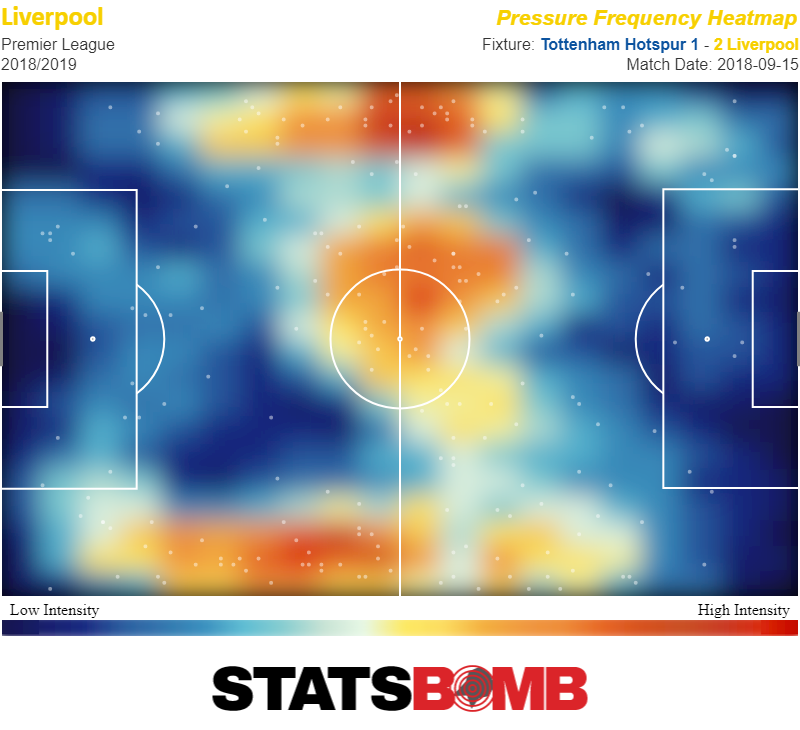
by the second time they faced off, Spurs approach forced Liverpool to adjust and made them do a lot more defending over the top and deeper down the flanks and halfspaces (especially on the right) in their own half.
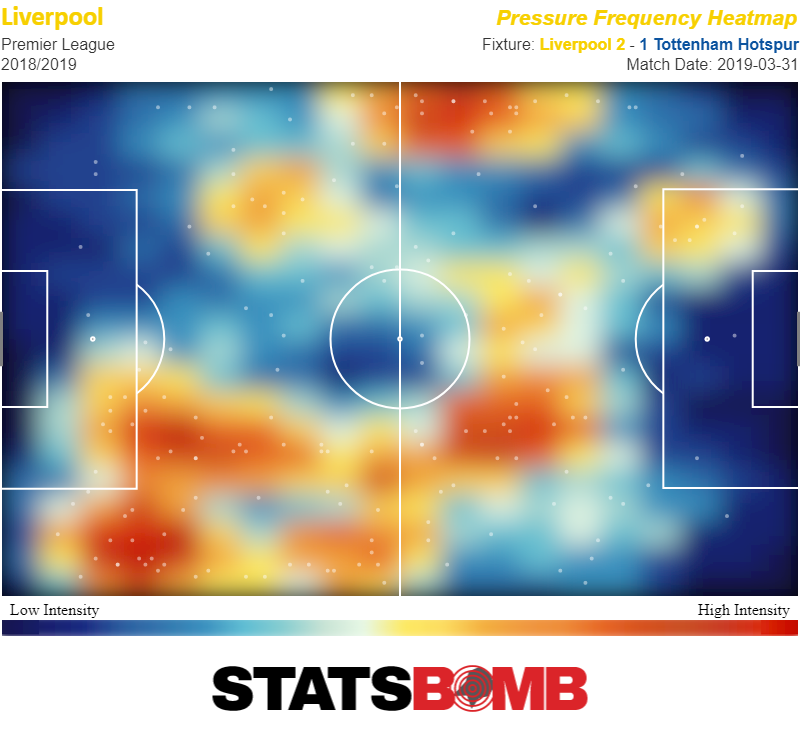
This may pose a particularly difficult challenge for Liverpool, whose primary ball progression and attack do not come through their midfield this season, but their fullbacks.
Mauricio Pochettino faces a tactical choice in the Champions League Final, but the ultimate question will be how best to use the sleek counterattacking force he created to not only create an against Liverpool’s stout defense but also to limit Liverpool’s forward thrust. Ten starters, with news of Harry Kane’s ankle injury recovering, seem to be locked in: In front of Lloris, Toby Alderweireld and Jan Vertonghen will likely have Rose and Trippier outside them. Sissoko, Dele, and Eriksen will be in midfield somewhere, and Son and Kane will be up top somewhere. The remaining question is whether Lucas Moura, Davinson Sanchez, Harry Winks, or Eric Dier fills in the eleventh slot.
Semifinal hero Lucas being left off as a starter may seem harsh, but Pochettino certainly trusts Kane here. If Lucas were to start, Spurs might run a more traditional 4-3-3, with Lucas and Son outside Kane and Eriksen at the base of a Sissoko-Dele trio. This set up would have the advantage of hampering Liverpool’s fullbacks from getting up the pitch, but would also leave Tottenham very light in midfield. Perhaps Pochettino might take that risk, with his defense packed relatively deeply and willing to forego a challenge in the midfield.
Most likely, Lucas will come off the bench in the match, with Winks or Dier starting at the base of a 4-4-2 diamond. It was this formation that gave Tottenham their best stretches this season. Ideally for Spurs, Winks would be fit and could start over Dier. While Dier at his best provides a heft Winks cannot match, defensively Winks came on this season as his ankle healed to provide as much ball winning as Dier. Winks also gives Tottenham a modicum of press resistance from the back, with his low turnover rate and accurate passing to his fullback outlets giving the team the chance to get a counterattack started before turning the ball over.
Stopping Liverpool’s press and attack is more or less impossible and going toe-to-toe with their press is a fool’s errand that Spurs fans are hopeful Pochettino has recognized. By utilizing the Air Raid approach, Tottenham may be able to defend in a deeper block, not get overextended, and keep Liverpool from playing their desired full metal soccer. Of course, Liverpool is extremely talented and the advantage of the Air Raid may not be sufficient, but it gives Tottenham its best chance to beat Liverpool and steal a big trophy, which has eluded them for decades.
Header image courtesy of the Press Association
